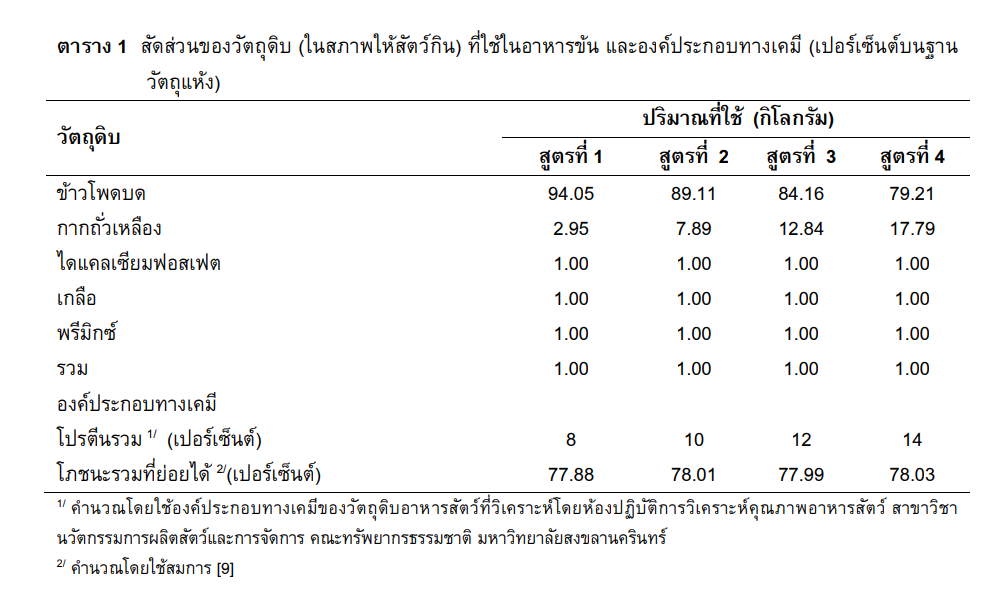Effects of protein levels in concentrate on growth performance and nutrient utilization of growing indigenous male goat
Keywords:
Dietary protein levels, Indigenous male goat, Growth performance, Nutrient utilizationAbstract
Effects of protein levels in concentrate on growth performance and nutrient utilization of growing indigenous male goat were studied. Sixteen Thai indigenous male goats, 5.81 ± 0.40 months old, with average body weight (BW) of 11.5 ± 2.1 kg, were randomly allocated into 4 treatments under a Completely Randomized Design for 180 days study period. Treatment diets consisted of pangola hay ad libitum supplemented with concentrate at 2% of BW (dry matter basis). Crude protein (CP) levels in concentrate were 8, 10, 12 and 14%, respectively. There were no significant differences (P>0.05) among treatments of total feed intake and hay intake while concentrate intake (40.39, 41.89, 42.67 and 43.12 g/KgBW0.75, respectively) and ADG of goats (37.96, 51.74, 50.00 and 56.25 g/d, respectively) increase linearly when the levels of CP in concentrate were increased. There was no effect of CP levels on digestibility coefficient of nutrients and nitrogen balance (P>0.05). Increasing CP contents in the concentrate significantly (P<0.05) increased the amount of nitrogen intake (5.36, 7.38, 8.73 and 9.35 g/d) and blood urea nitrogen (7.78, 11.45, 16.38 and 21.16 mg %). Therefore, the optimal CP level in concentrate for growing Thai indigenous male goat Thai fed with pangola hay, is 14% DM.
References
Monteiro A, Costa JM, Lima MJ. Goat System Productions: Advantages and Disadvantages to the Animal, Environment and Farmer. London: IntechOpen Limited; 2017. 366 p.
Department of Livestock Development [Internet]. Accessed 2020 February 1. Available from: http://ict.dld.go.th/webnew/index.php/th/service-ict/report/247-reportthailand-livestock.
Chobtang J, Intharak K, Isuwan A. Effects of dietary crude protein levels on nutrient digestibility and growth performance of Thai indigenous male goats. SJST 2009;31(6): 591-6.
Mohsin I, Shahid MQ, Haque MN, Ahmad N, Mustafa H. Effect of dietary protein level on growth and body condition score of male Beetal goats during summer. S. Afr. J. Anim. Sci. 2019; 49(5):898-901.
Pralomkarn W, Kochapakdee S, Saithanoo S. Energy and protein utilization for maintenance and growth of Thai native and Anglo-Nubian X Thai native male weaner goats. Small Rumin. Res. 1995; 16:13-20.
Choi SH, Kim SW, Park BY, Sang BD, Kim YK, Myung JH, Hur SN. Effects of dietary crude protein level on growth and meat quality of Korean native goats. J. Anim. Sci. Technol (kor) 2005; 47(5):783-8.
NRC. Nutrient Requirements of Goat: Angora, Dairy and Meat Goats in Temperate and Tropical Countries. Washington D.C: National Academy Press; 1981. 91 p.
Negesse T, Rodehutscord M, Pfeffer E. The effect of dietary crude protein level on intake, growth, protein retention and utilization of growth male Saanen kids. Small Rumin. Res. 2001; 39:243-51.
Kearl LC. Nutrient Requirements of Ruminants in Developing Countries. Utah: International Feed Stuffs Institue, Utah Agricuture Experiment Station Utha State University; 1982. 381 p.
AOAC. Official Methods of Analysis. 15th edition. Washington D.C: Association Official Analytical Chemists; 1990. 656 p.
Van Soest PJ, Robertson JB, Lewis BA. Methods for dietary fiber, neutral detergent fiber and non starch polysaccharides in relation to animal nutrition. J. Dairy Sci. 1991; 74(10):3583–97.
Steel RGD, Torrie JH. Principles and Procedures of Statistics (A Biometrics Approach). 2nd edition. New York: McGraw-Hill; 1980. 633 p.
Isuwan A, Chobtang J and Chankot T. Nutritive value evaluation of Digitaria eriantha hay and pellets at different regrowth intervals consumed in goats. Proceeding of the 9th National Kasetsart University Kamphaeng Saen Conference (KU-KPS); 2012 December 6-7; Kamphaeng Saen, Thailand. 2012.
National Bureau of Agricultural Commodity and Food Standards [Internet]. Accessed 2019 May 27. Available from: https://www.acfs.go.th/standard/download/eng/std%20_pangola_hay.pdf.
Manitoba Goat Association [Internet]. Accessed 2019 May 27. Available from: https://www.gov.mb.ca/agriculture/livestock/goat/pubs/goats-andtheirnutrition.pdf.
AFRC. The Nutrition of Goat. New York: CAB International; 1988. 118 p.
Suankool S, Boonruangkao A and Chobtang J. Effects of dietary protein levels on growth performance of Thai indigenous goats during 3 months to one year old. In: Animal Nutrition Division Annual Research Report. Surat Thani: Department of Livstock Development; 2009 p. 44-54.
Park JH, Kim SJ, Jang SY, Lee JW, Yun YS, Moon SH. Effects of dietary crude protein levels on intake, digestibility, and crude protein balance of growing Korean native goats (Capra Hircus Coreanae). J. Anim. Plant. Sci. 2018; 28(4):981-88.
Prieto I, Goetsh AL, Banskalieva V, Cameron M, Puchala R, Sahlu T, Dawson LJ, Coleman SW. Effects of dietary protein concentration on postweaning growth of Boer crossbred and Spanish goat wethers. J. Anim. Sci. 2000; 78:2275-81.
Wanapat M Ruminant Nutrition. Bangkok: Funny Publishing Limited Partnership: 1990. 437 p.
Lloyd S. Blood characteristics and the nutrition of ruminants. Br. Vet. J. 1982; 138(9):70-85.

Downloads
Published
How to Cite
Issue
Section
License
Copyright (c) 2021 Naresuan Phayao Journal

This work is licensed under a Creative Commons Attribution-NonCommercial-NoDerivatives 4.0 International License.
ผู้นิพนธ์ต้องรับผิดชอบข้อความในบทนิพนธ์ของตน มหาวิทยาลัยพะเยาไม่จำเป็นต้องเห็นด้วยกับบทความที่ตีพิมพ์เสมอไป ผู้สนใจสามารถคัดลอก และนำไปใช้ได้ แต่จะต้องขออนุมัติเจ้าของ และได้รับการอนุมัติเป็นลายลักษณ์อักษรก่อน พร้อมกับมีการอ้างอิงและกล่าวคำขอบคุณให้ถูกต้องด้วย
The authors are themselves responsible for their contents. Signed articles may not always reflect the opinion of University of Phayao. The articles can be reproduced and reprinted, provided that permission is given by the authors and acknowledgement must be given.







